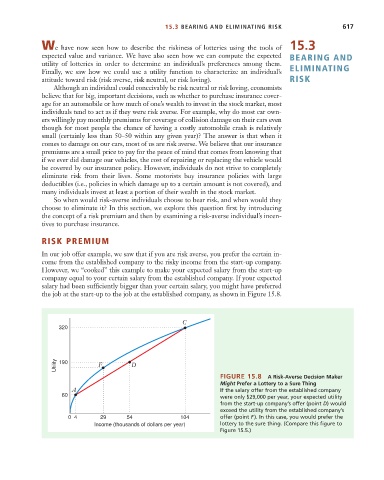Page 643 - Microeconomics, Fourth Edition
P. 643
c15riskandinformation.qxd 8/16/10 11:10 AM Page 617
15.3 BEARING AND ELIMINATING RISK 617
We have now seen how to describe the riskiness of lotteries using the tools of 15.3
expected value and variance. We have also seen how we can compute the expected BEARING AND
utility of lotteries in order to determine an individual’s preferences among them.
Finally, we saw how we could use a utility function to characterize an individual’s ELIMINATING
attitude toward risk (risk averse, risk neutral, or risk loving). RISK
Although an individual could conceivably be risk neutral or risk loving, economists
believe that for big, important decisions, such as whether to purchase insurance cover-
age for an automobile or how much of one’s wealth to invest in the stock market, most
individuals tend to act as if they were risk averse. For example, why do most car own-
ers willingly pay monthly premiums for coverage of collision damage on their cars even
though for most people the chance of having a costly automobile crash is relatively
small (certainly less than 50–50 within any given year)? The answer is that when it
comes to damage on our cars, most of us are risk averse. We believe that our insurance
premiums are a small price to pay for the peace of mind that comes from knowing that
if we ever did damage our vehicles, the cost of repairing or replacing the vehicle would
be covered by our insurance policy. However, individuals do not strive to completely
eliminate risk from their lives. Some motorists buy insurance policies with large
deductibles (i.e., policies in which damage up to a certain amount is not covered), and
many individuals invest at least a portion of their wealth in the stock market.
So when would risk-averse individuals choose to bear risk, and when would they
choose to eliminate it? In this section, we explore this question first by introducing
the concept of a risk premium and then by examining a risk-averse individual’s incen-
tives to purchase insurance.
RISK PREMIUM
In our job offer example, we saw that if you are risk averse, you prefer the certain in-
come from the established company to the risky income from the start-up company.
However, we “cooked” this example to make your expected salary from the start-up
company equal to your certain salary from the established company. If your expected
salary had been sufficiently bigger than your certain salary, you might have preferred
the job at the start-up to the job at the established company, as shown in Figure 15.8.
C
320
Utility 190 F D
FIGURE 15.8 A Risk-Averse Decision Maker
Might Prefer a Lottery to a Sure Thing
A If the salary offer from the established company
60 were only $29,000 per year, your expected utility
from the start-up company’s offer (point D) would
exceed the utility from the established company’s
04 29 54 104 offer (point F). In this case, you would prefer the
Income (thousands of dollars per year) lottery to the sure thing. (Compare this figure to
Figure 15.5.)

